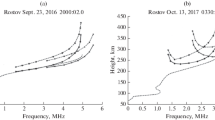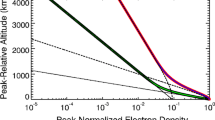Abstract
A method is proposed to determine the total height profiles of the electron density in the ionosphere with the use of topside satellite ionograms containing traces of sounding signal reflections from the Earth’s surface. The monotonic profile from the satellite to a certain height hm above the height hmF2 of the F2-layer maximum is calculated with the classical method based on reflections from the topside ionosphere. Below the height hm, down to the ionospheric base, the profile is represented by a system of interrelated analytical functions with a limited number of parameters. Their values are found with optimization methods and the joint use of traces of signal reflections, both from the outer part of the ionosphere and from the Earth. To increase the stability of the problem, the lower part of the sought profile in the E region is specified by an unchangeable profile from the IRI-2016 model. The method reliably determines the parameters of the hmF2 maximum, NmF2, and the profile in its vicinity. The addition of key parameters—hmF2, NmF2, and the additionally calculated values B0 and B1, which determine the profile shape in the F region—to the IRI model makes it possible to obtain an IRI profile that is corrected for the actual experimental conditions. The calculated and corrected profiles are similar in the bottomside ionosphere and can noticeably differ in the topside ionosphere. Thus, the use of this proposed method for the reconstruction of the total height profile of the electron density expands the informational value of topside satellite sounding of the ionosphere.












Similar content being viewed by others
REFERENCES
Bilitza, D., Altadill, D., Truhlik, D., et al., International reference ionosphere 2016: From ionospheric climate to real-time weather predictions, Space Weather, 2017, vol. 15, pp. 418–429. https://doi.org/10.1002/2016SW001593
Danilkin, N.P., On the acquisition and possible use of transionograms, Geomagn. Aeron., 1974, vol. 14, no. 2, pp. 369–371.
Danilkin, N.P., Transionospheric radiosounding as a tool for controlling the ionospheric state, in Ionosferno–magnitnaya sluzhba (The Ionospheric and Magnetic Service), Avdyushin, S.I. and Danilov, A.D., Eds., Leningrad: Gidrometeoizdat, 1987, pp. 79–110.
Danilkin, N.P., Transionospheric radiosounding (review), Geomagn. Aeron. (Engl. Transl.), 2017, vol. 57, no. 5, pp. 501–511. https://doi.org/10.1134/S0016793217050048
Danilkin, N.P., Denisenko, P.F., Kovalev, V.A., and Sotsky, V.V., On the possibility of using the method of regularization in the problem of transionospheric sounding, Geomagn. Aeron., 1987, vol. 27, no. 4, pp. 550–552.
Danilkin, N.P., Denisenko, P.F., and Sotsky, V.V., Peculiarities of the inverse problems of vertical radio sounding of the ionosphere, Adv. Space Res., 1988, vol. 8, no. 4, pp. (4)91–(4)94.
Denisenko, P.F. and Sotsky, V.V., Specific features of inverse problems of vertical radio sounding of the ionosphere (review), Izv. Sev.-Kavk. Nauchn. Tsentra Vyssh. Shk., Estestv. Nauki, 1987, no. 2, pp. 59–71.
Denisenko, P.F. and Sotsky, V.V., Reconstruction of the height profiles of the electron concentration based on vertical sounding data with the IRI model, Geomagn. Aeron. (Engl. Transl.), 2019, vol. 59, no. 6, pp. 726–737. https://doi.org/10.1134/S0016793219050037
Hudson, D.J., Statistics Lectures, Geneva: Eur. Org. Nucl. Res., 1963.
Ivanov, I.I. and Sotsky, V.V., Determination of the electron content distribution according to transionospheric sounding data using the IRI model, Izv. Vyssh. Uchebn. Zaved., Fiz., 2016, vol. 59, no. 12-2, pp. 126–129.
Ivanov, I., Maltseva, O., Sotskii, V., Tertyshnikov, A., and Zhbankov, G., Reverse satellite transionospheric sounding: Advantages and prospects, in Satellite Information Classification and Interpretation, Rustamov, R.B., Ed., London: InTech, 2018, ch. 4. https://doi.org/10.5772/intechopen.80240
Jackson, J.E., The reduction of topside ionograms to electron-density profiles, Proc. IEEE, 1969, vol. 57, no. 6, pp. 960–976.
Paul, A.K., Use of virtual-height slopes for determination of electron density profiles, Radio Sci., 1967, vol. 2, no. 10, pp. 1195–1204.
Tikhonov, A.N. and Arsenin, V.Ya., Metody resheniya nekorrektnykh zadach (Methods for Solving Ill-Posed Problems), Moscow: Nauka, 1979.
Funding
The study was supported by the Ministry of Science and Higher Education of the Russian Federation within the framework of the state contract in the area of scientific activity no. 0852-2020-0015.
Author information
Authors and Affiliations
Corresponding authors
Additional information
Translated by A. Nikol’skii
APPENDIX
APPENDIX
1.1 7.1. Group Refractive Index of Extraordinary Waves
We used expressions from Paul (1967):
Here, fH is the electron gyrofrequency, and θ is the angle between the wave vector (vertical) and vector of the geomagnetic field strength.
1.2 7.2. Matrix Elements for the Exponential Profile
Let
In dimensionless variables,
The group path in these variables is
Taking into account that
we obtain
Making the change of variables \(\tilde {X} = 1 - {{t}^{2}},~\) we find
where M(f) is the matrix element of the exponential profile.
1.3 7.3. Matrix Elements for the Quasi-Gaussian Profile
Let
Taking into account that
we obtain in new variables
Making the change of variables \(\tilde {X} = 1 - {{t}^{2}},\) we find
For signals reflected by the topside ionosphere,
the matrix element \({{A}_{{{\text{top}}}}}\left( {f,{{f}_{{\text{c}}}}} \right)~\) has the form
For signals reflected by the Earth’s surface,
for the height interval hmax ≤ h ≤ hm in the topside ionosphere. For the height interval in the bottomside ionosphere hB ≤ h ≤ hmax,
1.4 7.4. Matrix Elements for the Parabolic Profile
Let
The contribution to group paths is
Let us find the derivative
and substitute into the expression for \({{\Delta }}P_{x}^{'}\left( f \right)\):
Replacing the integration variable as \({{f}_{N}} = {{f}_{v}}\left( {1 + {{t}^{2}}} \right)\), we obtain
Thus, the expression for matrix elements \({{A}_{{vB}}}\left( f \right)\) takes the form
Rights and permissions
About this article
Cite this article
Denisenko, P.F., Sotsky, V.V. Reconstruction of Electron-Density Height Profiles Based in the Bottomside Ionosphere on Topside Satellite Sounding Data with the IRI Model. Geomagn. Aeron. 61, 241–258 (2021). https://doi.org/10.1134/S0016793221020067
Received:
Revised:
Accepted:
Published:
Issue Date:
DOI: https://doi.org/10.1134/S0016793221020067




